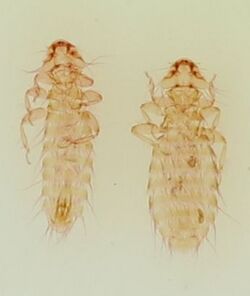Biology:Apterygon
| Apterygon | |
|---|---|

| |
| Female and male A. mirum | |
| Scientific classification Error creating thumbnail: Unable to save thumbnail to destination
| |
| Domain: | Eukaryota |
| Kingdom: | Animalia |
| Phylum: | Arthropoda |
| Class: | Insecta |
| Order: | Psocodea |
| Family: | Menoponidae |
| Genus: | Apterygon Clay, 1961 |
| Type species | |
| Apterygon mirum Clay, 1961
| |
| Species | |
| |
Apterygon is a genus of louse. It is endemic to New Zealand and is an ectoparasite of kiwi birds (Apteryx).[1] Theresa Clay circumscribed the genus in 1961.[2] In 1947, she had referred to this genus as "New Genus D", but it was not formally named as she needed to confirm the host of her specimen as well as additional material.[2][3]
Description
Apterygon heads lack preocular slits and the female genital chamber has a cellular circular structure.[4] They lack eyes, have a reduced hypopharynx and a well developed postnotum.[5]
Species
(As of 2017), four species are recognized in this genus.[1]
A. mirum, the type species of this genus, was described by Clay in the same paper which named the genus Apterygon. The holotype came from a North Island brown kiwi which was killed by a car in Ōpōtiki, New Zealand.[2] It is found in New Zealand's North Island.[1]
Clay described a second species for this genus, A. hintoni, in 1966. Its type host was a great spotted kiwi and its type locality was Nelson, New Zealand.[6] It is found in New Zealand's South Island.[1]
In 1972, B. K. Tandan described a third species, A. dumosum, based on specimens from a Stewart Island brown kiwi on Stewart Island, New Zealand.[5] It is found throughout New Zealand.[1] In addition to the Stewart Island brown kiwi, it parasitizes the South Island brown kiwi and the little spotted kiwi.[1]
The fourth species to be described was A. okarito, whose description by Ricardo L. Palma and Roger D. Price was published in 2004. Its type host is the Okarito kiwi, found in Okarito, New Zealand.[7] It is only found in Westland in New Zealand's South Island.[1]
Hosts
Lice in this genus are ectoparasites of all species of kiwi (Apteryx). The only other lice which parasitize kiwi are in the subgenus Rallicola (Aptericola).[1]
References
- ↑ 1.0 1.1 1.2 1.3 1.4 1.5 1.6 1.7 Palma, Ricardo L. (2017). Phthiraptera (Insecta) A catalogue of parasitic lice from New Zealand. Fauna of New Zealand. 76. Lincoln, New Zealand: Landcare Research. pp. 20, 39–41, 245. doi:10.7931/J2/FNZ.76. ISBN 978-0-947525-19-4.
- ↑ 2.0 2.1 2.2 Clay, Theresa (1960). "A new genus and species of Menoponidae (Mallophaga, Insecta) from Apteryx". Annals and Magazine of Natural History. Series 13 3 (33): 571–576. doi:10.1080/00222936008651059. http://www.phthiraptera.info/Publications/0553.pdf. Retrieved 2017-11-04.
- ↑ Clay, Theresa (1947). "A Preliminary Key to the Genera of the Menoponidae (Mallophaga)". Proceedings of the Zoological Society of London 117 (2–3): 457–477. doi:10.1111/j.1096-3642.1947.tb00532.x.
- ↑ Clay, Theresa (1969). "A key to the genera of the Menoponidae (Amblycera: Mallophaga: Insecta)". Bulletin of the British Museum (Natural History). Entomology 24 (1): 3–26. doi:10.5962/bhl.part.1517. https://biodiversitylibrary.org/page/2314106.
- ↑ 5.0 5.1 Tandan, B. K. (1972). "The Species of Apterygon (Insecta: Phthiraptera: Amblycera) Parasitic on Kiwis (Apteryx)". New Zealand Journal of Science 15 (1): 52–69. http://darwin.biology.utah.edu/pubshtml/LicePubPages/LicePDF%27s/1972/Tandan1972speciesApterygon.pdf. Retrieved 2017-11-04.
- ↑ Clay, Theresa (1966). "A New Species of Apterygon (Mallophaga: Menoponidae)". The Entomologist 99: 292–293. http://www.phthiraptera.info/Publications/4347.pdf. Retrieved 2017-11-04.
- ↑ Palma, Ricardo L.; Price, Roger D. (2004). "Apterygon okarito a new species of chewing louse (Insecta: Phthiraptera: Menoponidae) from the Okarito brown kiwi (Aves: Apterygiformes: Apterygidae)". New Zealand Journal of Zoology 31 (1): 67–73. doi:10.1080/03014223.2004.9518361.
Wikidata ☰ Q13654708 entry
 |

